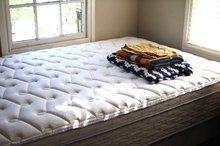How to Use Black Light to Diagnose Fungus
The most common way to diagnose fungal infections of the skin used to be a Wood's lamp, more commonly called a black light today. Not all fungi fluoresce in ultraviolet light, but many species do. Over time, these easy-to-spot species have been replaced by species that do not fluoresce, the major exception being ringworm, of which about half the species fluoresce in UV light 2.
Clean the suspected infection site. Because a wide variety of substances fluoresce under UV light, carefully clean the area to be inspected. Be sure to remove flaking skin, hair, makeup or topical medications that can obscure the infection.
Ultraviolet Light Used in Diagnosing Ringworm
Learn More
Activate the black light. Power your small, handheld black light by plugging it into an electrical outlet and switch it on. A portable lamp should be used so it can be brought close to the site of the potential fungal infection.
Hold the lamp close to skin. Bring the bulb of the lamp close to the infection site without actually touching it to the skin. If a ringworm or another fluorescent fungus is present, the site should glow bright green.
Do Scabies Show Under a Black Light?
Learn More
Confirm the diagnosis with a culture. A black light diagnosis should not be considered conclusive. Take a culture of the suspected fungus with a cotton swab and allow it to develop in a sealed culture media, or seek professional assistance.
Tips
Patchy hair or bald spots can be a symptom of fungus, but many of these species that cause those symptoms do not fluoresce under a black light. When in doubt, seek professional medical attention.
Warnings
Ringworm and other fungal infections spread easily through direct contact. Use caution around a suspected fungus. Wear disposable gloves and clean your hands thoroughly.
Related Articles
References
- Long Beach Animal Hospital: Ringworm
- Dog Chat: Ringworm in Dogs
- Melrose S. Seasonal affective disorder: an overview of assessment and treatment approaches. Depress Res Treat. 2015;2015:178564. doi:10.1155/2015/178564
- Pail G, Huf W, Pjrek E, et al. Bright-light therapy in the treatment of mood disorders. Neuropsychobiology. 2011;64(3):152-62. doi:10.1159/000328950
- The American Academy of Pediatrics. Depression Fact Sheet. 2020.
- The American Academy of Pediatrics. Getting outside, eating healthy foods help kids beat winter blues. Updated January 2012.
- Figueiro MG, Bierman A, Rea MS. A train of blue light pulses delivered through closed eyelids suppresses melatonin and phase shifts the human circadian system. Nat Sci Sleep. 2013;5:133-141. doi:10.2147/NSS.S52203
Tips
- Patchy hair or bald spots can be a symptom of fungus, but many of these species that cause those symptoms do not fluoresce under a black light. When in doubt, seek professional medical attention.
Warnings
- Ringworm and other fungal infections spread easily through direct contact. Use caution around a suspected fungus. Wear disposable gloves and clean your hands thoroughly.
Writer Bio
Joseph Nicholson is an independent analyst whose publishing achievements include a cover feature for "Futures Magazine" and a recurring column in the monthly newsletter of a private mint. He received a Bachelor of Arts in English from the University of Florida and is currently attending law school in San Francisco.






